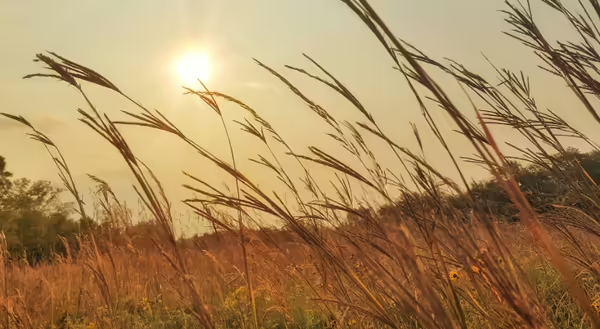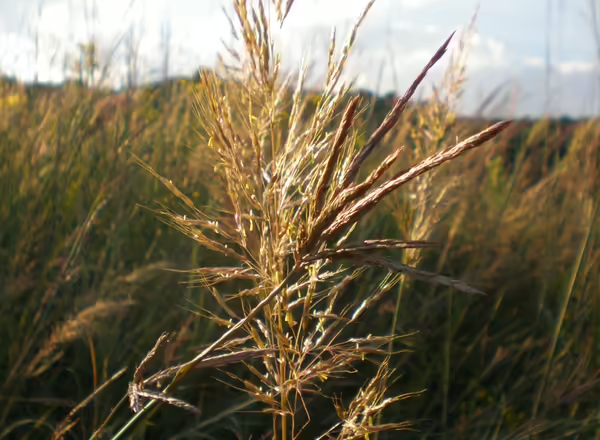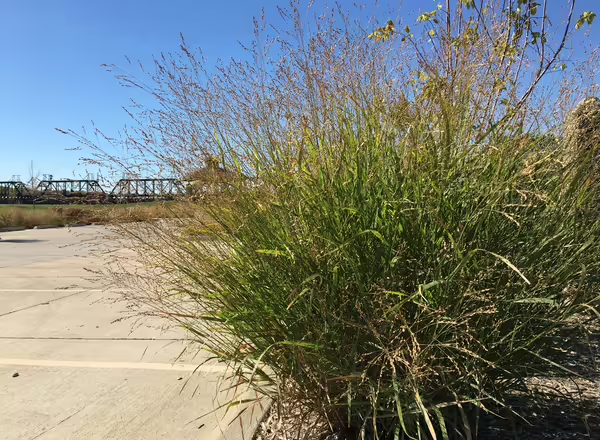
Illinois, nicknamed the Prairie State by early settlers, was once dominated by a tallgrass prairie ecosystem. Prairies are characterized by deep, fertile soils that are the result of thousands of years of supporting a diverse ecosystem of primarily herbaceous grasses and forbs, a few trees, and an abundance of wildlife. These ecosystems and the inhabitants of them were shaped by the ecological and climatic patterns of hot summers and cold winters, seasonal fire, and grazing bison.
Today, little remains of the original Illinois prairie, although many of the plant species native to the tallgrass prairie ecosystem are useful in our modern landscape. The Illinois Pollinators website is a wealth of information for anyone interested in any one of the dozens of native plants recommended for the home landscape. Flowering plants, grasses, shrubs, and trees can be found on this list as well as pre-planned gardens for inspiration.
Below is a deeper dive into the big three, the large grass species that inspired the name tallgrass prairie.
Big Bluestem (Andropogon gerardii)
Big Bluestem (Andropogon gerardii), the state grass of Illinois, is a warm-season, bunch grass that can reach heights up to eight feet. Like most prairie plants, Big Bluestem requires full sun and is tolerant of a wide range of soil types. The species prefers moist to slightly dry conditions in loam or clay-loam soils but will tolerate quick-drying sand and gravelly soils. The common name reflects the propensity of the species to develop blueish hues as autumn progresses. Another common name for Big Bluestem is Turkeyfoot, which draws inspiration from the shape of the three-sectioned seed head.
In a natural ecosystem, Big Bluestem provides habitat cover for nesting birds and forage for mammals. It is a larval host for multiple skipper butterfly species. In a designed landscape, Andropogon gerardii can be used in multiple ways to add dimension and interest. The vertical nature and unique fall color of Big Bluestem can be used as a focal point. It can be planted in mass to create a backdrop or screen or interplanted with other native plants to add texture, form, and color to a naturalized landscape.
Yellow Indiangrass (Sorghastrum nutans)
Yellow Indiangrass (Sorghastrum nutans) is a large warm-season bunchgrass that can reach heights of 4 to 7 feet. During the growing season, the foliage appears as a blue-green color, fading to golden hues in the fall. Like Big Bluestem, Yellow Indiangrass is well adapted to a variety of sites and soil conditions but prefers deep, moist soils.
Sorghastrum nutans is a larval host plant for butterflies and moth species, and its seeds are enjoyed by birds and small mammals. In a designed landscape, Yellow Indiangrass stands out in the autumn after producing a golden plume-shaped seed head. The seed head is ornamental and persists into the winter months. It can be used as a focal point but is more often utilized in naturalized plantings, along borders, or for erosion control.
Switchgrass (Panicum virgatum)
Switchgrass (Panicum virgatum) is a sod forming, warm-season perennial that grows up to 6 feet in height. Switchgrass is highly adaptable, thriving in moist to mesic conditions with the ability to adapt to drier conditions. The dense, deep root system will tolerate nearly any soil type, including poorly drained and rocky soils.
In the tallgrass prairie ecosystem, Switchgrass is useful for erosion control, carbon sequestration, and wildlife habitat. The foliage is a useful food source for grazing animals throughout the growing season. Seeds are enjoyed by small mammals and birds, and numerous insects feed on the leaves during early life stages.
In the designed landscape, the open, airy seedhead adds texture and interest, and its adaptability makes it useful for challenging areas such as wet locations or erosion-prone slopes. Caution should be taken when incorporating Switchgrass into the landscape, as it can spread by rhizome or seed, increasing its ability to spread throughout a garden or landscape.
Grasses in the garden
Incorporating tallgrass prairie species into a design can provide an opportunity to enhance ecological and aesthetic impact. These three large grasses, once established, are drought-tolerant, require minimal maintenance, and support biodiversity in the form of food and habitat for birds and beneficial insects. The robust root systems help improve soil structure and water infiltration.
Although far removed from the native prairie ecosystem, the big grasses are ideal for those looking for a more sustainable landscape that harkens back to the Illinois tallgrass prairie.
Good Growing Fact of the Week: Andropogon gerardii ‘Blackhawks’ was named 2026 Perennial Plant of the Year® by the Perennial Plant Association.
Bonus Good Growing Fact of the Week: Recent research is demonstrating the potential of Switchgrass as a biofuel. Some early evaluations indicate that Switchgrass may be a useful source as an alternative fuel due to its high biomass yield and resilience.
Thank you for reading!
Sign up for our emails! Want to get notified when new Good Growing posts are available? SIGN ME UP
Give us feedback! How helpful was this information (click one): Very helpful | Somewhat helpful | Not very helpful
MEET THE AUTHOR
Emily Swihart is a horticulture educator with University of Illinois Extension, serving Henry, Mercer, Rock Island, and Stark counties since 2021. Emily provides horticulture programming with an emphasis on the home gardener, the urban forest, native plant ecosystems, and landscape design. Additional responsibilities include supporting local county Master Gardener and Master Naturalist volunteers - providing training, continuing education, advanced training, and their involvement in seasonal events and community outreach programs.

